Trending
Opinion: How will Project 2025 impact game developers?
The Heritage Foundation's manifesto for the possible next administration could do great harm to many, including large portions of the game development community.

Featured Blog | This community-written post highlights the best of what the game industry has to offer. Read more like it on the Game Developer Blogs or learn how to Submit Your Own Blog Post
In this article, I will try to describe the design process and the various challenges we faced along the way of making "Children of Morta".

When we talk about a story-driven roguelike game, we neither only mean a video game with a mix of micro-narratives and a ludic loop, nor one that uses visual representations to convey an ideally coherent world. In fact, the most challenging claim in Children of Morta was bringing a plot-driven game together with gameplay that is mostly inspired by major elements of roguelike games.
As one of the designers on Children of Morta, who was added around the first quarter of the project, also the narrative designer and writer for the game, I will try my best to run you through our design process and the challenges we faced along the way.
Children of Morta (henceforth referred to as CoM) was born in 2014 (almost five years before its final launch) through crowdfunding; and like many of its peers that sought funding on Kickstarter, it too presented a basic idea that was almost oxymoronic, namely, a story-driven roguelike. But there was also the retro and stylistic art of the game that depicted the Bergson family in the midst of a fictional world where their adventures would take place.
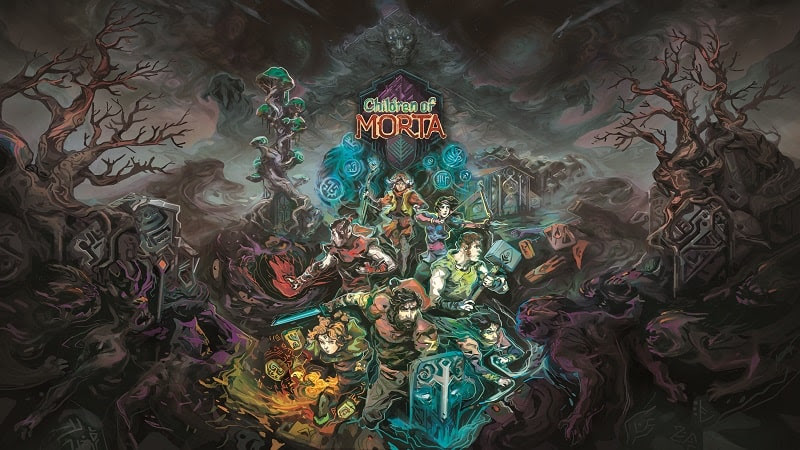
After funding was secured, it seemed like the game wasn’t going to be a mere roguelike or hack ’n’ slash. CoM owes a lot to pioneering games like Diablo. However, while Diablo set itself apart by breaking the genre norms to incorporate real-time combat and balance out permadeath, CoM tries to achieve the same by returning to some of its classic roots. We wanted to stand by our promises of delivering a heartfelt story about the Bergsons and at the same time revisit the core elements of rogue-like games. This meant that the players were going to experience the story in between the procedural levels and the Bergsons’ house. To this end, we required a form of permadeath for the playable characters, so the game had to flow without a checkpoint system.
An important keyword used during the Kickstarter campaign was “family” and the fact that each of the main characters would be a part of it. This alone pushed our character development process a step above the class-character of RPGs. And since we needed the Bergsons to be a family, we had to portray their relationships in an authentic manner. This kept us busy well into the final months of development. Now let’s go over how the Bergsons came to be.
Initially, the game was supposed to be narrated in a book. So, players would see the book in-game and realize that they’re reliving the stories within it. The book would retell the story of total strangers who would unite around a central plot. They would meet each other in an inn and while there, something evil would occur forcing them to band together and go on a heroic journey.
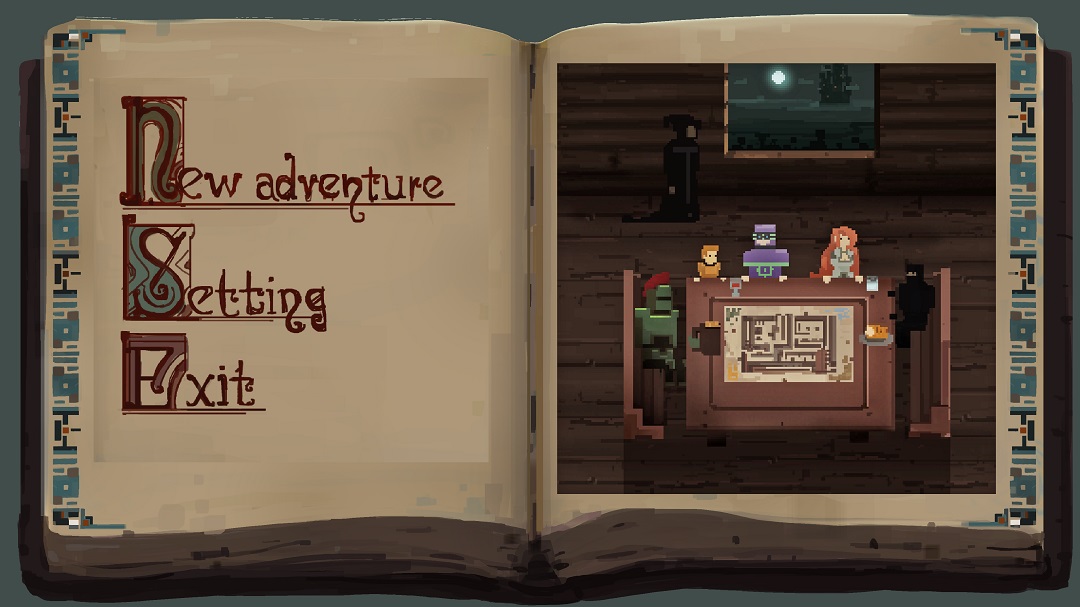
But the Kickstarter campaign needed unique elements. Some of which were already made: In fact, our art style was reminiscent of impressionist palettes and most of our animations gave the player a certain “anime” vibe found in the works of Miyazaki. But what we lacked was something to hold together the narrative and the roguelike gameplay and emphasize this unique mixture. An element that would be our unique selling point. This was the concept of “family” which was the result of many a brainstorming session. The family angle was something that caught the attention of many of our backers; that’s how a narrative-driven roguelike centered on a family named the Bergsons was able to surpass its goal on Kickstarter.
Using genres to define a game has always come with issues regarding their interpretation. You’ll be faced with definitions that don’t refer to a single, uniform essence. But that’s just how things are on crowdfunding sites, you can’t really avoid this model of presentation since, in the end, you have a game that isn’t finished and if you don’t have the prototypes to be showcased, you’ll need to introduce the game in ways people are already familiar with. So, these labels are actually handy when used properly. People are familiar with the bold characteristics of these definitions to a degree, even though each of them has been undergoing numerous changes during the last three decades.
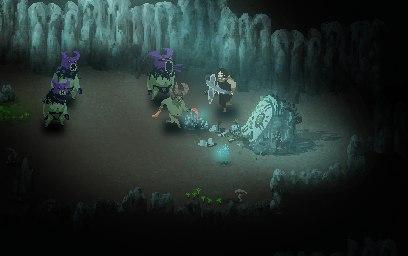
ARPG was the first one mentioned. But that alone wouldn’t allow for the innovation we had in mind since there were already loads of ARPGs that were also narrative-driven. So we had to revisit the roots of the genre. But that didn’t mean using turn-based combat even though early roguelike titles did function that way. Also being narrative-driven or more precisely, story-driven was something that would directly contradict what defined a roguelike game which made this a pretty big deal and at first glance our initial design would be understood as that. That’s how we ended up adding permadeath and procedural levels containing random events alongside the story as the primary pillars of our design.
Morta needed serious Hack n Slash, but not solely be a Hack n Slash, as many of the previous ARPG titles before it were not pure Hack n Slash games but also delivered a story. The Hack n Slash element of the game was in fact a knob for us to adjust the complexity of enemy behaviors and playable characters within the combat system. It was clear from the beginning that we didn’t want to be a pure ARPG similar to Diablo and Titan Quest, nor a modern roguelike similar to The Binding of Isaac or Risk of Rain.
In CoM, the existence of procedural levels as a defining characteristic of the genre and also as a way of increasing variety and replayability can be summed up in three parts: creating levels with different geometries and visuals, spreading enemies in different ways across levels and finally chances of finding random items and power-ups. You also need to find a way to include micro-narrative events in-line with gameplay events. Even though your level design costs go down with this feature, the complexity and design challenges go up.
The initial level designs were fairly simple; one could even say they visually resembled the level design of early roguelike titles. The levels consisted of separate, predesigned rooms that were connected through machine-generated corridors. The spread of enemies throughout levels was uncontrollable. The enemies would spawn in random places within a room, aside from the corridors, without a predetermined pattern. So, their spawn patterns were unpredictable for the designers.
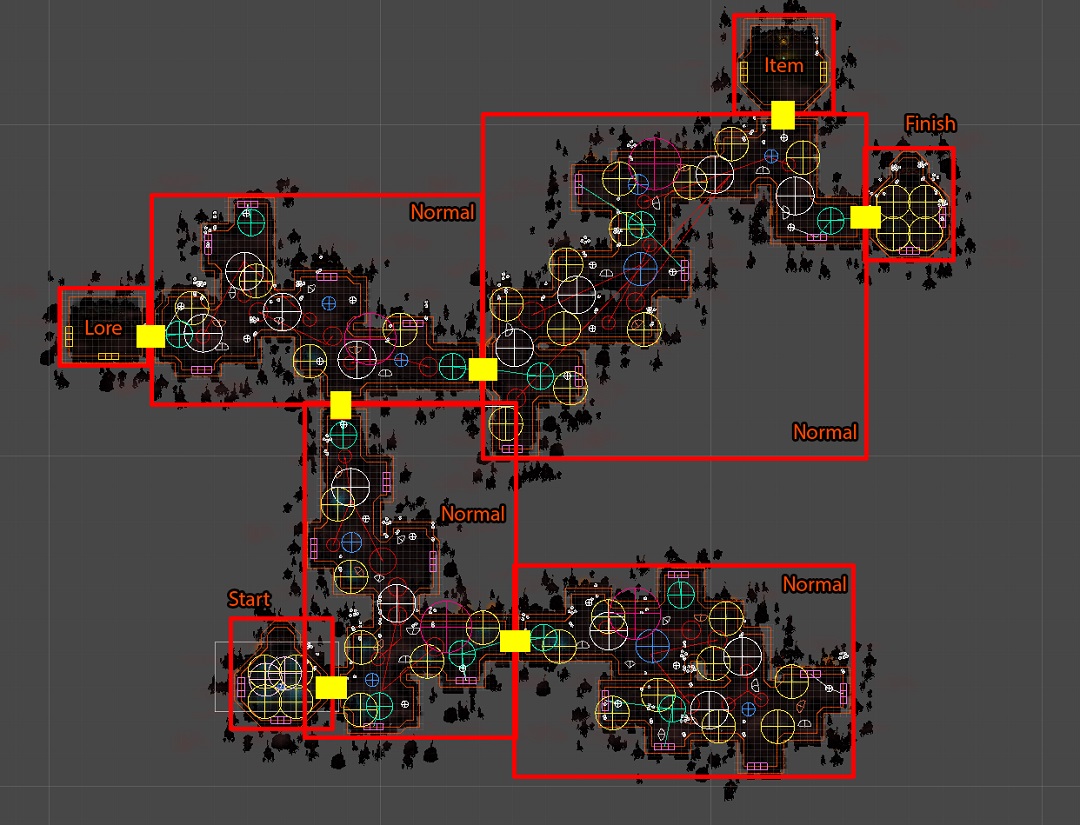
The visuals of the initial levels were made by placing ground and wall tiles in a grid formation. Right from the get-go, we noticed that the walls and ground were too flat and also the placement of the walls looked too bland. This was even more noticeable in natural environments. So, the decision to connect the walls to a tile before or after it was soon replaced with adjustable connections that can be even less than one tile. This feature gave us the ability to create a variety of geometric visuals that were not previously available in our initial prototype.
The initial game design was based on our promise on the Kickstarter campaign which stated that we would stick to 2 principles: one is dynamic gameplay and the other a narrative set around family bonds. This brought loads of challenges on board. In the case of gameplay, aside from issues pertaining to the number of playable characters and their different fighting styles, we also had to think of a way to create playthrough variation and think of a rewarding progression system. These were matters that were the subject of much discussion well into the final months of the project. In the midst of all this, our real issue was with the narrative, or rather the story; bringing together a story with this gameplay in a genre that historically has been without narrative was tough, especially when the story has a clear narrative arc.
In many past roguelike titles like The Binding of Isaac and more recently Enter the Gungeon, you have a distinct avatar as your playable character that doesn’t change throughout the game. Not being able to change your character is very efficient both from a design and an asset creation standpoint. But in CoM you don’t just do ranged combat like in Isaac and Enter the Gungeon, and your character variation isn’t similar to Risk of Rain and Nuclear Throne whose characters mostly differed in terms of their visuals. In fact, CoM was aiming to be similar to ARPGs like Diablo in this regard which had unique playable characters each portrayed in a meaningfully distinct way. This specifically made the design and asset creation more difficult.

In the Kickstarter campaign, we introduced six main playable characters that covered the scope of almost all the main classes in RPGs. From John who fights his foes at close range with his shield and sword to Lucy and Linda who are ranged damage dealers but we needed to make them distinctly different in terms of playstyle. Our efforts to make each character distinct can be seen in their design and visuals as well. Their abilities needed to be different in a meaningful way; their fighting style and visual cues during encounters needed to be taken into consideration so much so that the distinctness in fights required us to create many standardized behaviors for the enemies and bosses.
In the end, maintaining the meaningfulness of this vast cast of characters with their different abilities made balancing the game very complex and challenging. A challenge that kept us occupied till the end of the project.
Almost from the start, we made the decision to make the Bergsons’ house act as the game’s hub. They were a family and the very least thing we could do to display that was to show them living together under the same roof. The Bergsons would go on missions and after every defeat or victory, they’d return to their home. However, this assumption had its own impact on the design of the whole game. From a narrative view, the house represented a place where family events would take place; from a practical view, the house needed to have an impact on the characters’ progression. So we created two functional sections that also fit the narrative well. Uncle Ben’s workshop and Grandma Margaret’s alchemy table were added to the house and were essential to the player’s progression. Uncle Ben would create combat equipment for the Bergsons which would permanently upgrade their character attributes; Grandma Margaret would create different consumables and the player would be able to carry a limited number of them for a run as temporary progression aid.
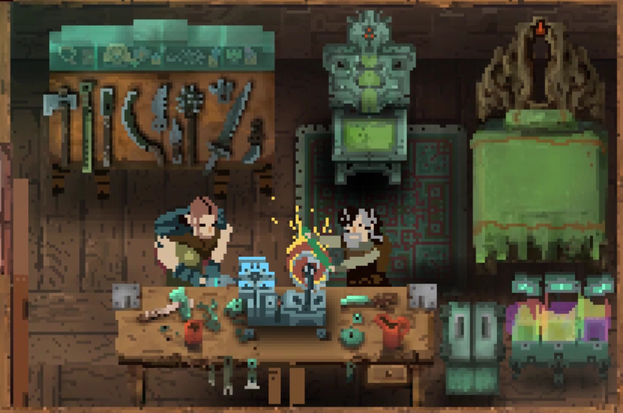
From the beginning, progression in CoM was focused on three main things: First, the player’s motor skills will adapt to their favorite character(s) which in of itself is dependent upon factors like getting over the difficulty curve, proper tutorials, etc. Second, permanent and temporary progression through collecting resources and power-ups, creating items and spending resources on upgrades either within the levels or at home. This type of combination had no place within classic roguelike titles. But something we were looking into during this time was an instant and unique progression in the form of power-ups that could be stacked to create variety with each run and even sometimes stumbling upon a random build that would allow the player to progress tremendously. Third, a narrative progression which the game’s whole flow depended upon. To be honest we didn’t know in what shape, where, in what order and how frequent story events should have been shown. What was obvious was that we needed to create a proper flow of challenges, rewards and narrative progression within the game.
When we were asked what the game we were making was about we usually said: “Well, it’s about a family” but as you can imagine that didn’t cut it. Imagine a Hack n Slash game but before you start the game, a panel pops out telling you: “The characters you’re going to play as are a family”, and the rest is up to your imagination to figure out how they’re related to one another; the feelings among them and what they’ve gone through. That is rather strange, don’t you think? Though maybe not that strange for a tabletop RPG, but Children of Morta wasn’t that kind of a game.
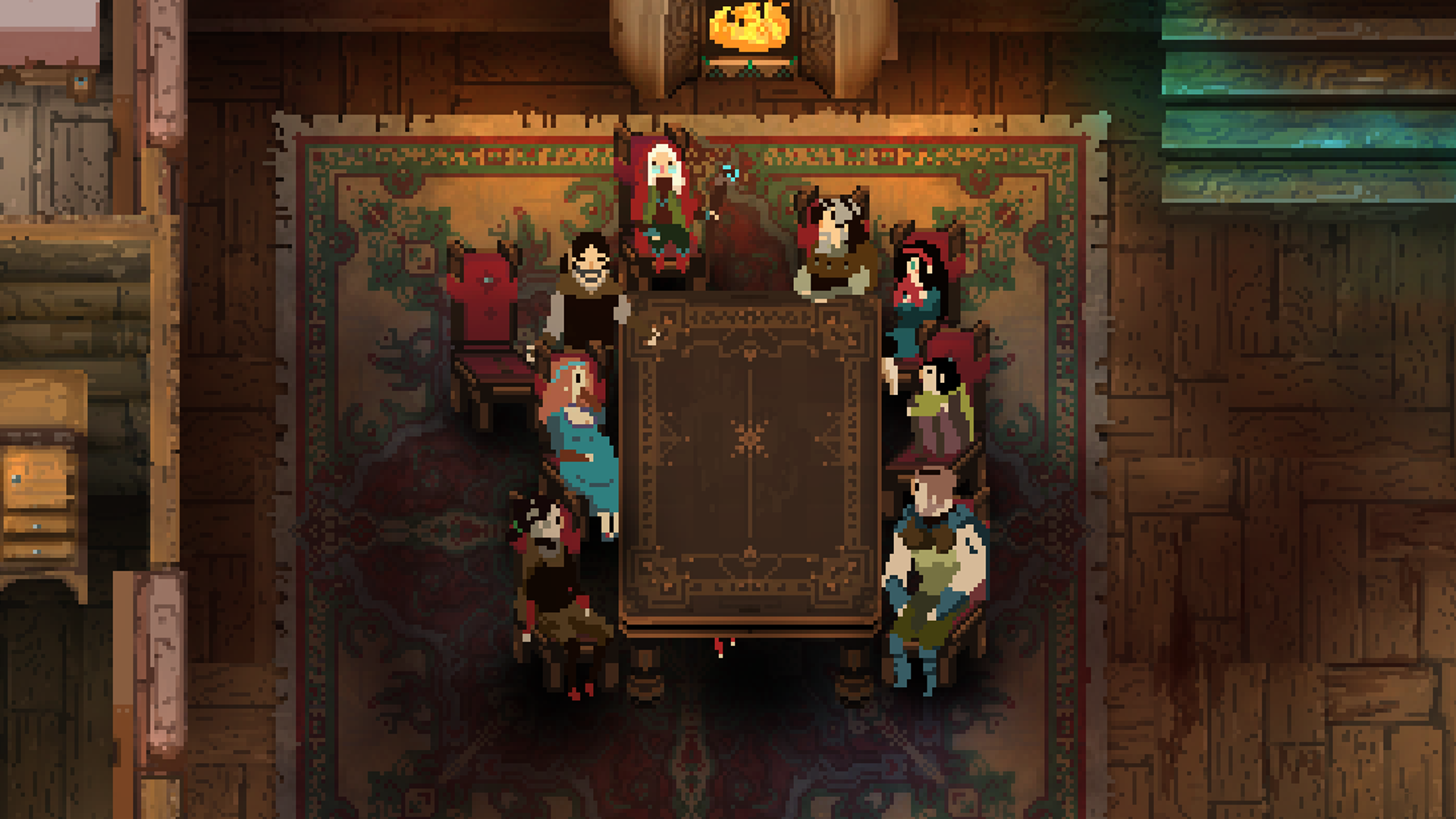
Around the time our Kickstarter campaign succeeded in reaching its goal, we were flooded with comments on what our backers thought the game could be, especially with regard to the family-centered aspect of the story. This shows that everyone had their own conception of what it means to be a family, and if our heroes were going to be part of a family then we had to at least do the bare minimum to fulfill that concept. This is where we made our biggest mistake: we didn’t pay nearly enough attention to this important theme for about 3 years. In fact, we didn’t do much else other than creating a half-baked family mood system and a number of brief character descriptions that showed their family relations. Our negligence continued until halfway through the project. That’s when we gradually started asking ourselves what we’d need to do to show they’re a family. More importantly, how would we be able to accurately represent those relations throughout our game?
If the Bergsons are a family, which of their characteristics would need to stand out? Their altruism and sense of responsibility? Or their feelings for one another? Their disappointment in one another or their compassion and mercy for each other? All of these could be traits found in a perfect family. But we needed an “Other” to embolden this sense of family unity. So we came up with a unifying pattern; one which the Bergsons would unite over, learn to trust one another, lead them to sacrifice themselves in dire situations, and in the end defeat the corruption. This pattern provided a much-needed opportunity to have another go at characterization; in fact, each playable character would become playable due to the various narrative nodes created for them which would be used to introduce them.
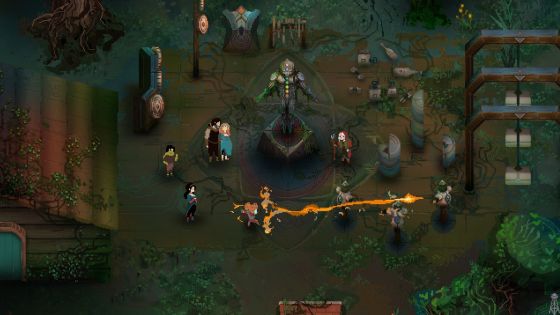
This would also alleviate our concerns regarding the gameplay becoming repetitive and boring after a while since we would be able to introduce different mechanics to the player through the gradual unlocking of playable characters until the second chapter. With this in mind and together with the fatigue system, the player would be more incentivized to try their hand at different characters.
What impact have the family members had on each other? This was an important question for us since we were able to determine and highlight instances where their relationship can be emboldened. Some of the relations would be explored and represented through narrative means and at times through different gameplay systems.
We had a lot of different ideas on how to represent the family’s bond through gameplay. The Bergsons would be able to accompany each other on missions and even help each other out should they be in a pinch. Many of these ideas were visited and prototyped somewhere near the end of the project but were later scrapped due to the level of complexity in implementing them. Although, some of them were implemented in a more toned-down fashion.
Among the various ideas to better cover the relations of the Bergsons, micro-events were designed for the in-run levels which showed the Bergsons cooperating with each other. Most of these events happened in a room. Sometimes one of the Bergsons would help another member, or help them in finding treasures or even accompany them when helping out NPCs.
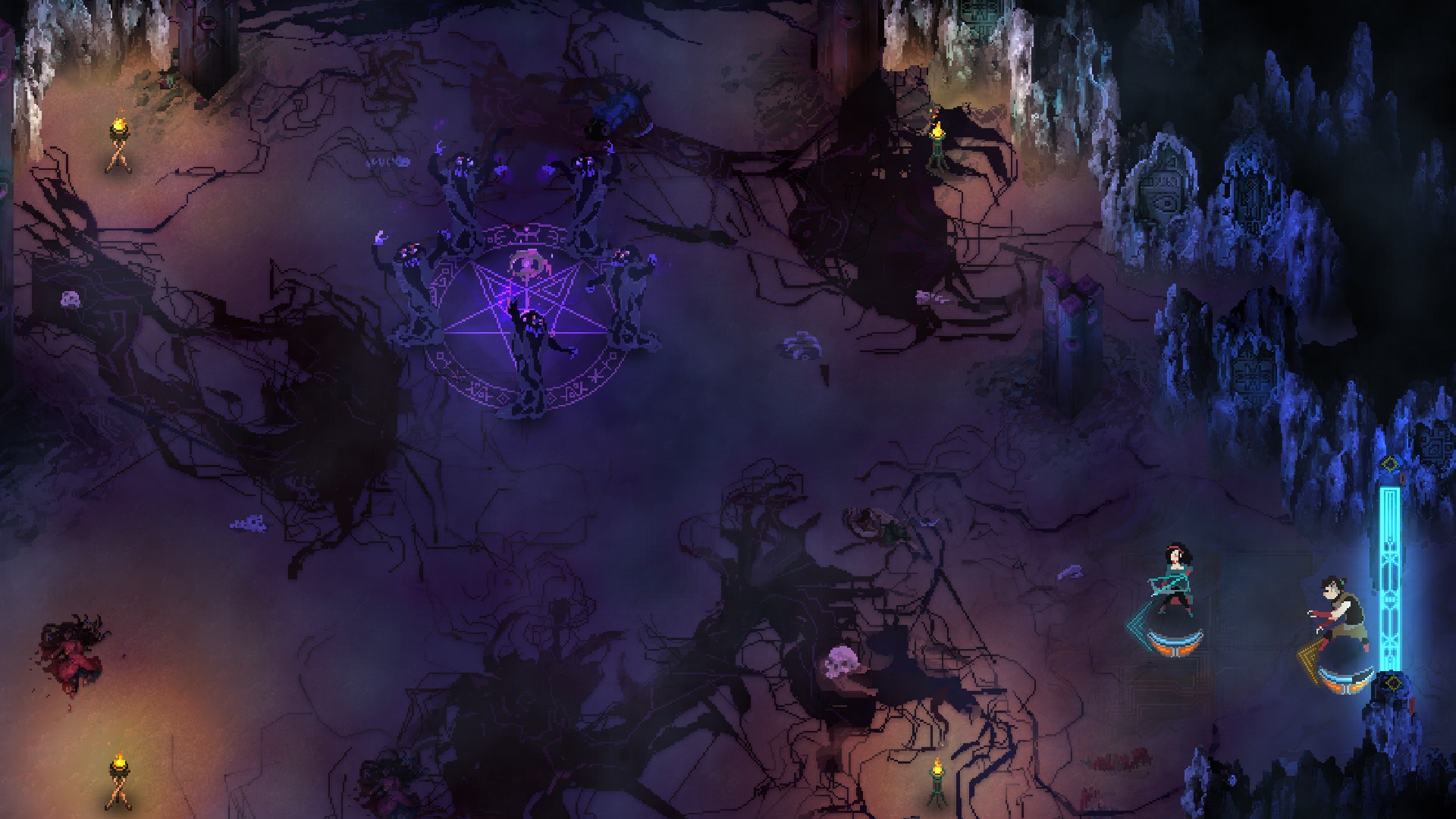
The Bergsons’ continued existence alongside one another throughout the levels was a neat idea but the number of these events, while not too costly in terms of art assets, would be so high that we wouldn’t possibly be able to maintain the same level of meaningful quality other events had. So considering the very limited time we had, we decided to remove many of them altogether; very few of them made the final cut.
One of the most crucial systems that was created in the game to represent family bonds was the Family Traits system the Bergsons shared with each other that would indicate their spiritual bond.
Initially, we were looking for a way for the Bergsons to come to each other’s aid. In the end, this form of aid was implemented in the game in two ways. First, they would be paired up during narrative micro-events and after it ended they would separate. But these micro-events were completely random and limited in terms of how many there were; also, the player didn’t have much control over them. The solution was that the family members would quickly come to each other’s rescue in critical situations. So technically, the Bergsons would be able to summon an astral projection of each other in the heat of battle.

This summoning feature was later turned into a separate system in the game; in a way, it tried to mix the game’s narrative with gameplay. In fact, we had come to the conclusion that if the Bergsons are able to summon astral projections of one another, they must have other spiritual effects on each other. These effects later became known as Family Traits and were placed in the Bergsons’ skill tree. Players would be able to unlock these spiritual bonds by spending more points in their skill tree which would be of benefit to all the Bergsons. To sum up, by progressing in their skill tree each Bergson would be able to transfer four traits that acted as buffs to their attributes to other family members. This way the family’s bond would come to life in a practical fashion in the form of traits.
Each run in Children of Morta would take about 20 to 25 minutes to complete. This was a much longer time frame compared to other similar games; and once the player dies, they might not have made any tangible ludic and narrative progression. This is precisely what became a major cause for concern halfway through the project. We feared that players wouldn’t experience a sense of progression after playing for a certain amount of time.
One of the major revisions that took place halfway through the project was progression segmentation; in other words, the progression was given a form of resolution. This revision entailed three major changes: First, the length of the levels in an area were shortened to convey a more coherent sense of progression. Second, specific checkpoints were implemented after finishing each area. Initially, the checkpoints were activated under the condition of completing the chapter but now each area had its own checkpoint and there are around three areas in each chapter.
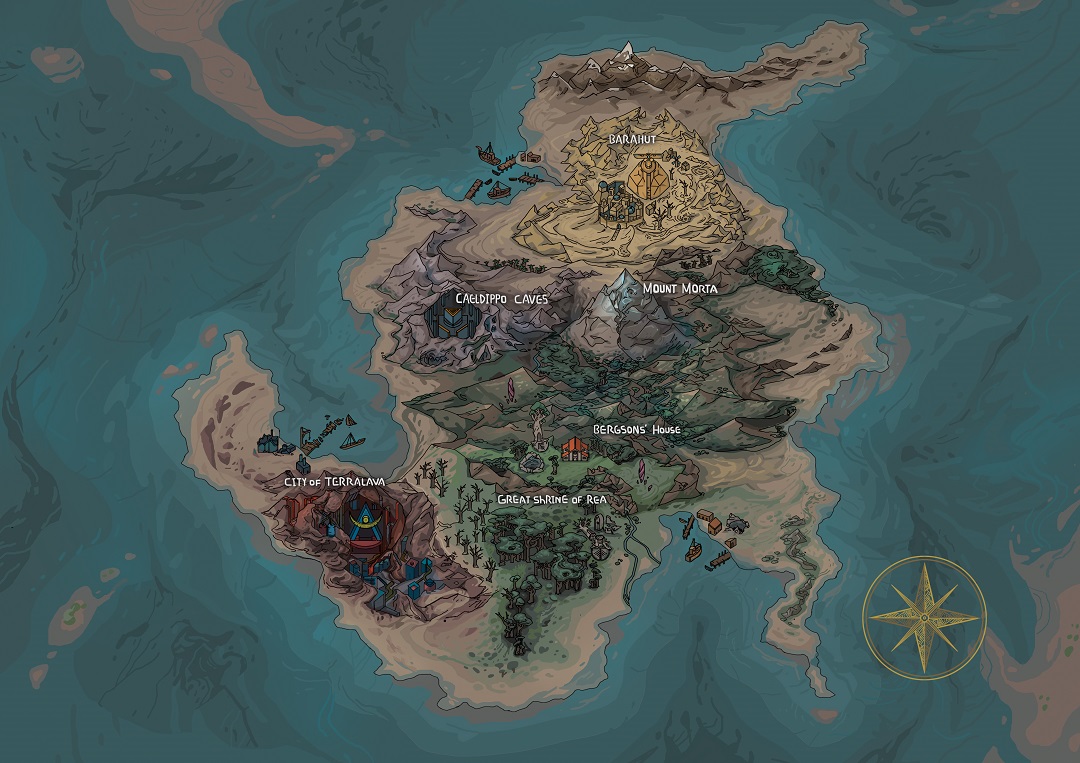
This decision did not have much of an impact on each play session’s length but in general, it impacted the total playtime of the game. Third, focuses more on the narrative resolution of each area. In fact, we had considered one final boss for each chapter in our early design which was reduced to a total of five—including the final chapter—after the number of chapters was limited. But before any of that, we had designed and implemented a number of minibosses that the player would face in random events or side quests. The decision to break-up areas called for a change in the functional form of the minibosses to be considered as main bosses and to increase their number. As such, certain points were taken into consideration in each final area where the player would defeat the boss and return home to save the progress they’ve made. This was precisely the part we would be able to utilize to move the story forward.
The house was important ludic-wise; it was also an opportunity to showcase the relationship between the Bergsons. Relationships that would need to leave a lasting impression throughout the gameplay. Initially, we believed that our characters would be able to fulfill the functions we had considered for them with their basic roles.
Their mother, Mary, would cook for them. So we decided to prototype a system where the Bergsons would find and bring home different ingredients needed to prepare a meal. Those meals would temporarily buff the Bergsons. Alongside this cooking system, we also had prototyped a gardening system that would allow Grandma Margaret to use the harvested goods in her potions and also unlock more complex recipes in Mary's cooking.
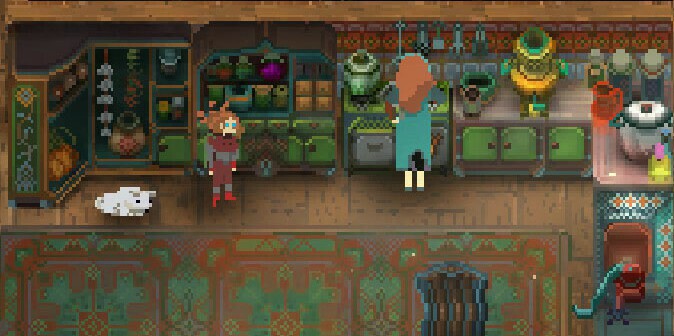
A CMS was starting to take root in the house that was not quite good. We didn’t want the game’s flow to fall off. In fact, our game didn’t have that much of a slow pace to warrant players to devote a long time to resource management, growing and building different power-ups. It was also unclear for us at that point, how much progress would need to occur inside the house and whether all these slightly complex tasks of growing herbs and cooking would be as effective—in terms of progression—as power-ups inside levels and upgrades done through Uncle Ben’s workshop. Also, would we be able to balance out this complicated and loaded system with the player’s progression throughout the levels?
Since there were no clear answers to these questions, we decided to scrap the prototype in the end. We couldn’t devote time to both fixing existing issues while also creating an effective and uniform side system that would be in-line with the game’s core loop. In the end, what we went with was certain house functions such as Uncle Ben’s workshop and Grandma Margaret’s alchemy table; both of which were implemented in a basic fashion whose shared resource would be gathered throughout the levels.
Initially, we didn’t have a clear vision of what kind of narrative and story structure could be implemented in the roguelike format. The basic structure for events, quests and also where the story would unfold were somewhat predetermined; but under what conditions, in what form and sequence they would be showcased was still a matter of much deliberation. Also, designing the world required much more time and care. In fact, the visual references needed to be more aligned with the environment and narrative arc. The game’s opening scene didn’t evoke a positive first impression from a story perspective. The heroes and villains' ambitions needed to be better outlined. There was also the matter of taking more care when designing the relationship of the Bergsons since it would be the focal point of the story; and finally, to consider other mediums through which to deliver the world’s lore. Now, I will get into some of the measures taken to deal with the concerns mentioned above.
The Bergsons’ home could still be used as a conduit to create more narrative experiences. In fact, we needed events that would highlight the relationship between the Bergsons while also providing a better understanding of the main plot. Another way to look at it would be that these events cloud help the player keep track of the game’s main objective.
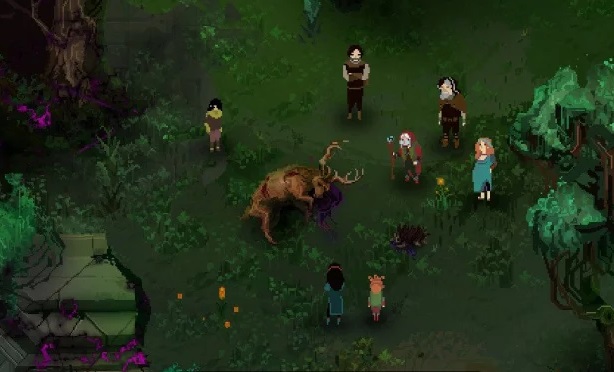
These events that were referred to as HIE were based on an idea where the main cutscenes of the game would have an interactive element but that never got implemented. So based on its structure, and the narrative needs of the game, HIE was used as another narrative delivery medium. The player would encounter one or a few HIEs at home and choose to see what happens when they interact with it. These events were mostly easy to pull off due to the art assets required and their narrative nature could repeatedly be used in different situations.
One of the main concerns when designing Children of Morta was the total game time and how narrative events should be distributed considering the game time. Admittedly, we had a game that was reliant upon the player’s skill level to a large degree; this would have a significant impact on how long the game would be. This situation had created a paradox: More skilled players would probably bypass many of these narrative events and never experience them. Events that were a bit of an oddity in non-roguelike games since the player would have to die enough times to trigger them. These players would eventually discover the story much sooner than planned and would miss key plot points. This issue became a major challenge since game time was itself reliant upon the player’s death rate and an important factor in designing the narrative, which in turn made balancing the game a difficult task to overcome.
Players die in-game; some more, some less. The player who has not died would possibly not see much and the one who has died many times would stop seeing events after a while. There were many ideas. Should the game’s flow be cut at some point and the player be forced back at home to watch the story unfold? Or would it be wiser to transfer some of those key narrative events from the house to the levels? What was obvious was that with the segmentation of levels and a more tangible progression system (which was previously mentioned) we had more room to flesh out the story. Therefore, we considered the template of returning the player back home after they defeat the boss of an area to be the default and placed all the main resolution nodes which progressed the story at home and after each boss is defeated.
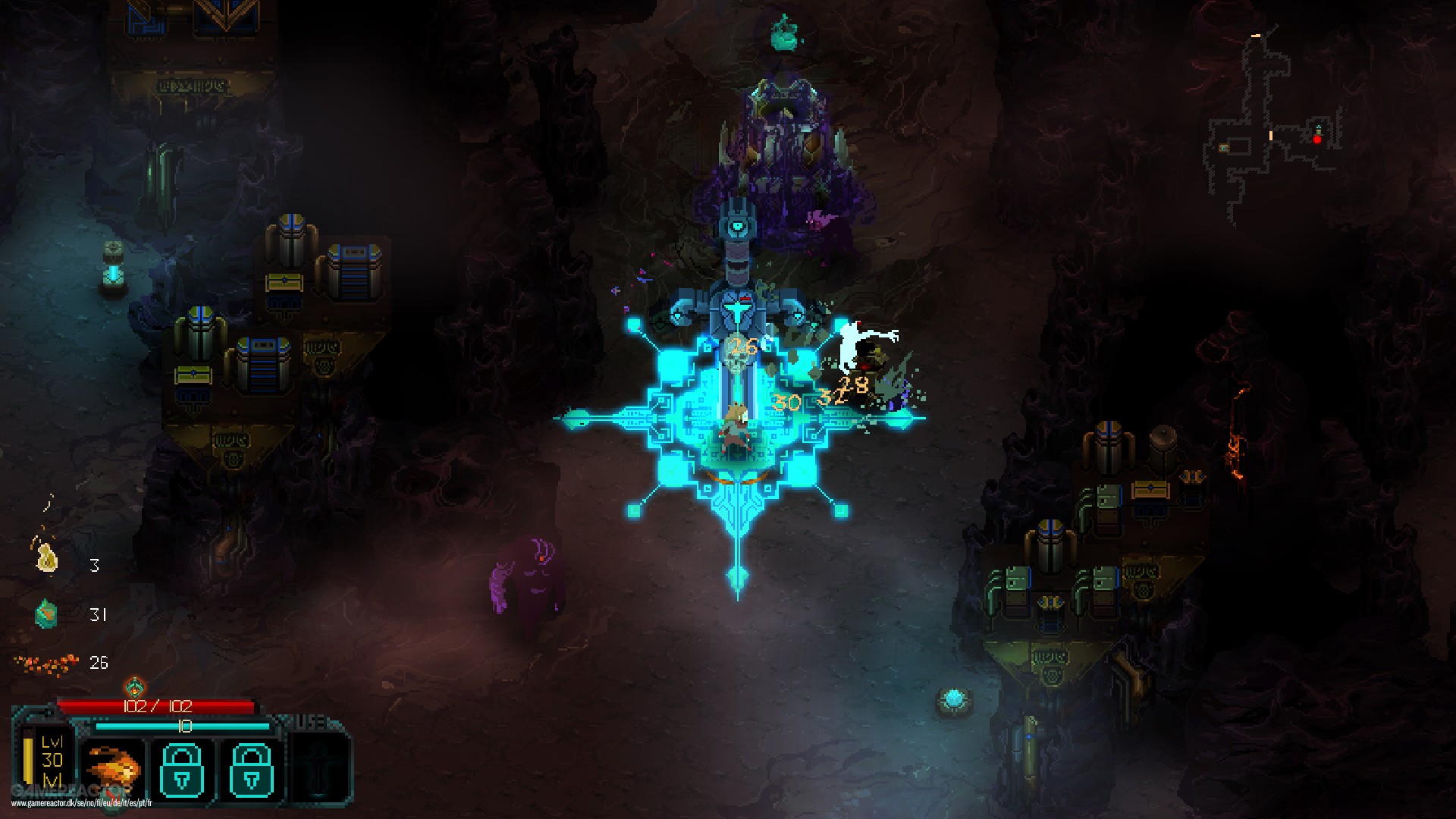
Due to multiple deaths during the game, the player might be susceptible to lose track of the game’s main storyline and in fact lose sight of their main goal. Certain measures were taken into effect to resolve this matter. First, a basic objective system was embedded in the UI. Many of the events and cutscenes were also rewritten from scratch to convey everything that was necessary for the player to understand the story while staying on track. Finally, a narration was written for each of the starting rooms that would implicitly remind the player of their short-term goal in that level.
To highlight the family’s end goal, we needed a situation where a sense of urgency would be conveyed to the player. So for each phase of the game, a series of events were designed to indicate the spread of corruption in the world. Though this progression was also implicitly mentioned in the form of HIEs and also some cutscenes. The difference being these events would put the home in an irreversible state, making it seem as if the Bergsons are starting to feel the tension and no longer feeling safe in their own home which acts as a buffer for the sense of urgency.
The cutscenes carried the load of characterization, which by their very nature aren’t very suitable for transferring background information and to set the scene for the narrative. So we also decided to utilize other mediums to enrich our characters.
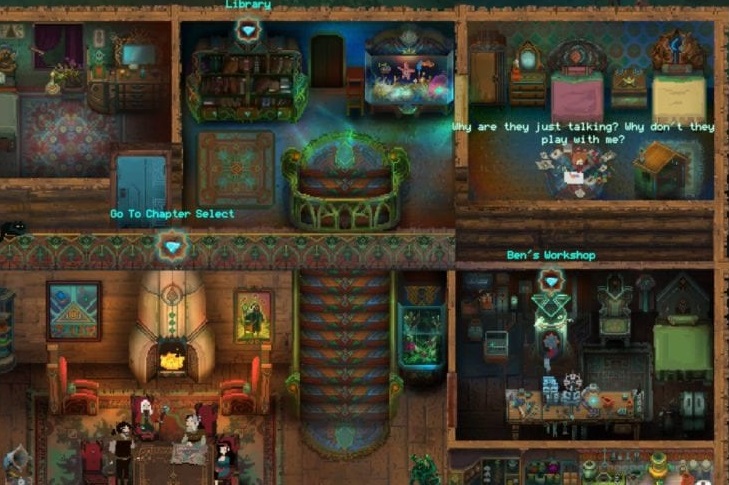
We needed to present the inner thoughts and attitudes of the Bergsons to make them seem more believable and real. So we went with mental state bubbles which seemed like the appropriate medium for representing the characters’ state of mind. The Bergsons’ thoughts would float above their heads which had been previously implemented in many games before it; so that wasn’t much of a challenge except for maybe figuring out the order and time in which these thoughts would appear. To this end, we created a categorization system that would reveal the thoughts of the Bergsons depending on story events that had taken place inside the house and levels. However, there was the possibility that many of these events would overlap. So we decided to redesign the mental state bubble system to also include a priority system that would prioritize a certain thought depending on the importance of the situation a Bergson was in. This addition caused the thought bubbles to appear based on a predetermined order and relevant to the events of the game.
A family journal for the Bergsons was added around the tail end of the production cycle; in other words, when the characters had enough depth to cause the player to want to learn more about them and their background should they be very interested in the story. And so, backgrounds were written for each of the family members to make their ambitions and emotions seem more realistic and justifiable.
The burden of creating art assets for the narrative sections of the game proved to be highly challenging during production. In fact, considering we only had 2 people working on the art, any changes to the narrative would warrant recreating many art assets. Obviously, the game’s story, as well as the many cutscenes, carried a significant toll in terms of the art that needed to be made. Even though we actively tried to reuse certain scenes, there was no shortage of specific animations that needed to be created from scratch.
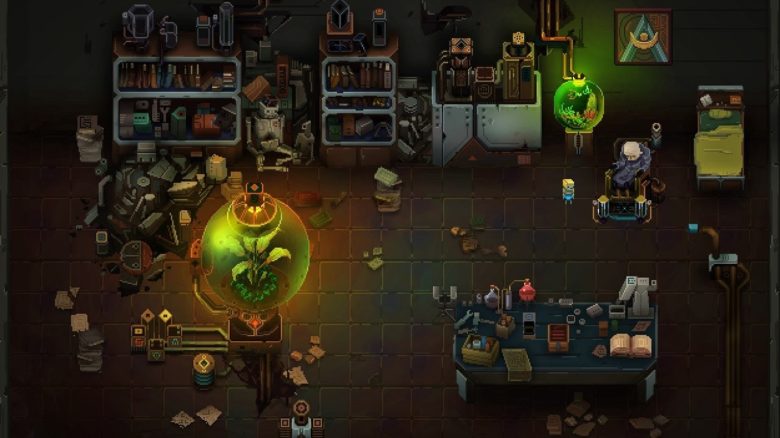
The quality of the pixel art was another important matter for us. For example, the opening cutscene was the cause of much debate around the office. The cutscene opens with Grandma Margaret’s nightmare which had a different resolution from the rest of the cutscenes. However, this was not the only cutscene that had a different resolution; the last cutscene of the game also varied to a degree in this regard. This cutscene was both different in terms of its resolution and shot angles. Though overall, the game’s isometric view was rarely changed during cutscenes. Truth be told, this kind of change in the shot angles was only used in certain predetermined places which overall made it in sync with the totality of the game and other cutscenes.
We almost had every necessary narrative medium for the game near the end of the final development phase. Story cutscenes, Home Interactive Events (HIEs), Mental Bubbles, and also the narrations for each starting room would be a suitable opportunity for delivering relevant story information to the player and remind them of their goal. We initially assumed that if the right content is shown at the right place and time, then our work is done. But that was merely an assumption. Many designs and prototypes were created that involved countless tweaks and revamping sessions.
One of the more serious matters during this time was the overlapping of narrative moments. This wasn’t something to be overlooked. All in all, there was a very high chance for the player’s narrative experience to be significantly altered depending on their skill level. In order to deal with this, a series of prioritizations were implemented in the narrative system depending on the number of events. This prioritization decided which cutscenes or HIEs would be shown where and at which time; what the sequencing of the mental bubbles would be and how many times they’d be shown; and which starting room narration would be more important at that point and time. All these systems were constantly being tweaked well into the final days of the project until they were suitable for the game’s narrative proportions.
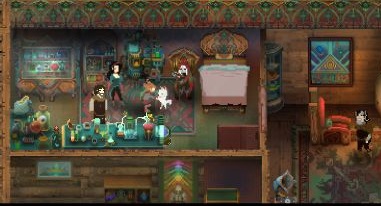
Near the end, we still had reservations regarding our design choices since none of us had that much experience with such complex narrative systems. Although, the feedback we received during the final months was really heartwarming and made us feel a bit at ease. Still, there were many parameters to be considered in these decisions some of which were contradictory at times.
Now I will discuss my thoughts on choices and assumptions regarding the design; which even if we don’t designate as contradictory, had some faults in narrative, gameplay and ludo-narrative aspects, three of which I will detail below.
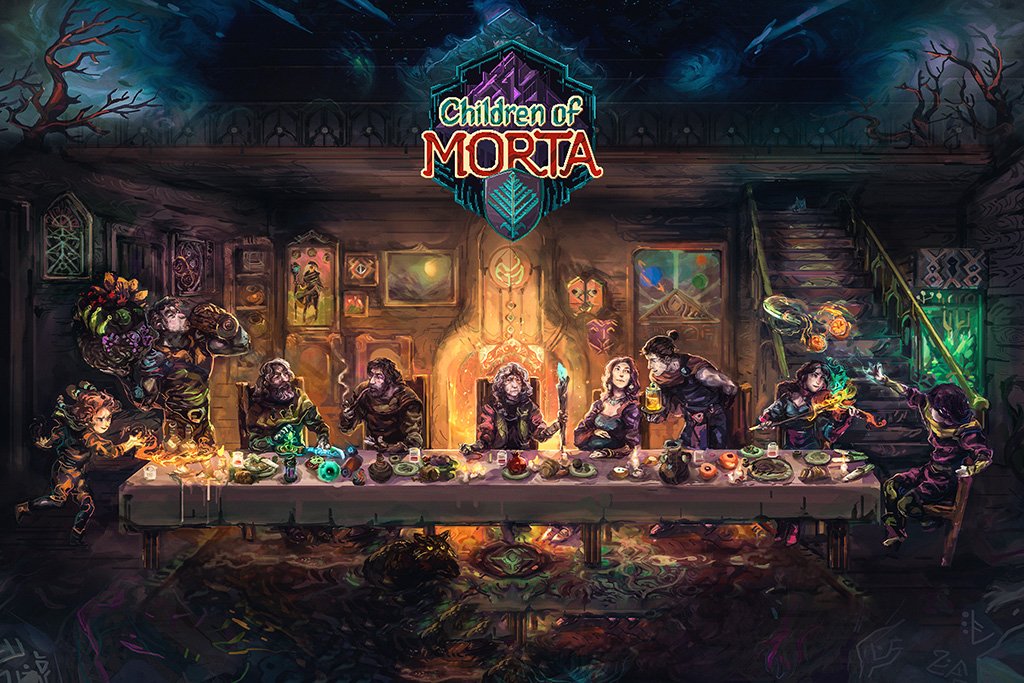
When you’re a small indie team, you need to find your niche in this saturated market where indie titles get trampled over every day. As a result, you can’t really disregard the trends in the market. Children of Morta entered the fray with bold claims of a narrative-driven roguelike and mesmerizing art on Kickstarter; we presented certain early claims in an effort to secure funding which later became our base assumptions in creating the game. Claims which if pulled off successfully would put us on the map next to critically acclaimed games in the genre. One of our most important claims was the total number of playable characters.
We had six playable characters on our roster in addition to a character made in honor of our most generous backer. Considering our art team, indie status and the graphics we were going with, we needed to take this offer and the serious issues that came with it into account. In fact, we took on loads of expenses for each of the playable characters, both from a narrative perspective and their fighting styles. Half of which we could’ve spent to introduce more variety in enemies, bosses, challenges and also in-game events. Regardless, we were trying to make a narrative-driven roguelike with pixel graphics not an ARPG with a rich cast of playable characters.
Due to structural issues in team composition, the game’s design suffered from a lack of unified vision which could’ve been used as pillars on which the game could be built upon. Hence many important decisions that needed a clear-cut and economically feasible approach were taken in a chaotic swirl of brainstorming and discussion sessions of designers in a very vague way causing them to fall short. Some of these decisions didn’t meet a favorable end and at times would be scrapped with numerous prototypes. In other words, if we had a general overview to base all micro-decisions on, it would in turn decrease decision-making costs and lower total costs, focus the design team better and also shorten the development time of the game.
Combat and progression systems saw numerous prototypes up until the end of the project, some of which were referred to above. Very few of them made the final cut and luckily, they blended well with the narrative. Some, like the Bergsons’ family traits system, even though they could’ve been made to have a more active role in the game, remained the same and adequately took form in the narrative. Some systems like the fatigue system could have potentially helped enrich the family’s relationship but due to the problems mentioned it was not implemented and was only presented in the UI.
The need for a more meaningful and mature display of the Bergsons’ in-level relationship was vividly felt by most; leaving them to want more. Although, there were numerous attempts to fill this gap by introducing events to highlight their relationship; it still wasn’t enough. In the end, many of them were cut due to time constraints not leaving enough time to figure out design complexities and lack of polish.
The design and development of Children of Morta had a lot of ups and downs. Most of the design issues we encountered are mentioned above. Regardless, with all the structural problems during the development of Children of Morta, I feel that we were able to create an adequate synthesis of roguelike characteristics and RPGs. But to what degree and in what form these characteristics were implemented would need a separate piece so we can explore all of its details.
Read more about:
Featured BlogsYou May Also Like